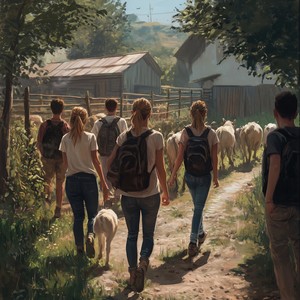Jak uspět u ústní zkoušky u maturity z angličtiny a získat vynikající hodnocení, když si vytáhnete maturitní otázku na téma Animals and Wildlife (Zvířata a divoká příroda)? Tuto otázku si klade většina maturantů z angličtiny, když se na ústní zkoušku poctivě připravují. Abychom to všem maturantům z AJ co nejvíce usnadnili, připravil Nový Amos vypracované otázky na všechna maturitní témata angličtina, která se u ústní maturity z AJ objevují úplně nejčastěji. Postupně si také projdeme všechny dovednosti na mluvení (speaking) anglicky na dané téma. Tak pojďme na to, uvidíte, že sice úplně zadarmo nebude, ale s trochou přípravy to zvládneme a u maturity z angličtiny uspějeme.
Vypracovaný text na maturitní téma Animals and Wildlife
Introduction to Animals and Wildlife
Animals and wildlife are an essential part of our planet’s ecosystem. They contribute to biodiversity and play important roles in maintaining the balance of nature. However, many species are now endangered due to human activities like deforestation, pollution, and climate change. Protecting animals and wildlife is crucial for preserving our environment.
Importance of Biodiversity
Biodiversity refers to the variety of life on Earth, including different species of animals, plants, and microorganisms. High biodiversity is important because it ensures ecosystem stability and resilience. Every species plays a role in the ecosystem, whether as a predator, prey, or decomposer. Loss of biodiversity can lead to the collapse of ecosystems.
Endangered Species
An endangered species is one that is at risk of extinction. Many animals become endangered due to habitat loss, hunting, and climate change. Protecting endangered species is important because once a species is lost, it cannot be recovered. Conservation efforts are necessary to save these species and preserve biodiversity.
Habitat Destruction
Habitat destruction is one of the biggest threats to wildlife. As human populations grow, more land is cleared for agriculture, urban development, and industrial activities. This destroys the natural habitats of many animals, forcing them to migrate, adapt, or face extinction. Protecting natural habitats is key to wildlife conservation.
The Role of Zoos and Sanctuaries
Zoos and wildlife sanctuaries play an important role in conservation. They provide safe environments for endangered species and help educate the public about wildlife conservation. Many zoos participate in breeding programs to increase the populations of endangered species. However, the role of zoos is sometimes debated, with concerns about animal welfare in captivity.
Wildlife Conservation Efforts
Wildlife conservation efforts are aimed at protecting animals and their habitats. These efforts can include creating protected areas, such as national parks, enforcing anti-poaching laws, and restoring damaged ecosystems. Conservation organizations work around the world to protect wildlife and raise awareness about the importance of biodiversity.
Human-Wildlife Conflict
Human-wildlife conflict occurs when animals and humans compete for the same resources, such as land, water, or food. This can lead to dangerous encounters, where animals are killed to protect human lives or property. Finding ways to coexist with wildlife is important for both human safety and wildlife conservation.
Climate Change and Wildlife
Climate change is having a significant impact on wildlife. Rising temperatures, changing weather patterns, and shifting ecosystems are forcing many species to adapt quickly or face extinction. For example, polar bears are losing their sea ice habitat due to global warming. Addressing climate change is essential for protecting wildlife.
The Impact of Pollution
Pollution, such as plastic waste, chemicals, and oil spills, poses a serious threat to wildlife. Animals can ingest or become entangled in plastic, leading to injury or death. Chemicals and pollutants can contaminate water and soil, affecting the health of entire ecosystems. Reducing pollution is crucial for the health of wildlife.
The Future of Wildlife
The future of wildlife depends on the actions we take today. Protecting natural habitats, reducing pollution, and addressing climate change are all critical for ensuring that future generations can enjoy the rich diversity of life on Earth. Conservation efforts must continue to evolve and adapt to new challenges to be effective.
Otázky zkoušejícího na vypracovaný text na téma Animals and Wildlife
- Why is biodiversity important for the environment?
- What are some causes of species becoming endangered?
- How does habitat destruction affect wildlife?
- What role do zoos play in wildlife conservation?
- What are the benefits and challenges of wildlife conservation efforts?
- How can we protect endangered species?
- What are some examples of human-wildlife conflict?
- How does climate change impact wildlife?
- What are the effects of pollution on animals?
- How can we reduce pollution to protect wildlife?
- What is the importance of protecting natural habitats?
- How can individuals contribute to wildlife conservation?
- Why is it important to address human-wildlife conflict?
- What are some successful examples of wildlife conservation?
- What do you think the future holds for endangered species?
Vzor odpovědí na otázky zkoušejícího
- Why is biodiversity important for the environment? Biodiversity is important because it helps keep ecosystems stable and resilient. Each species plays a specific role in the environment, and losing even one can disrupt the balance of nature.
- What are some causes of species becoming endangered? Species become endangered due to habitat loss, hunting, pollution, and climate change. These factors can reduce populations and make it difficult for species to survive.
- How does habitat destruction affect wildlife? Habitat destruction forces animals to migrate, adapt to new environments, or face extinction. It is one of the biggest threats to wildlife, as it removes the places where animals live and find food.
- What role do zoos play in wildlife conservation? Zoos help protect endangered species by providing safe environments and participating in breeding programs. They also educate the public about the importance of wildlife conservation.
- What are the benefits and challenges of wildlife conservation efforts? The benefits of wildlife conservation include protecting species from extinction and preserving biodiversity. The challenges include limited resources, human-wildlife conflict, and the need for international cooperation.
- How can we protect endangered species? We can protect endangered species by creating protected areas, enforcing anti-poaching laws, and supporting conservation organizations. Reducing habitat destruction and pollution are also important.
- What are some examples of human-wildlife conflict? Examples of human-wildlife conflict include farmers killing predators that threaten their livestock or animals damaging crops. These conflicts can lead to the death of animals and loss of livelihoods for humans.
- How does climate change impact wildlife? Climate change affects wildlife by altering habitats, changing migration patterns, and reducing the availability of food and water. Some species may not be able to adapt quickly enough to survive.
- What are the effects of pollution on animals? Pollution can harm animals by causing injury or death, contaminating their food and water, and damaging their habitats. For example, plastic waste can entangle animals or be ingested, leading to health problems.
- How can we reduce pollution to protect wildlife? We can reduce pollution by recycling, reducing plastic use, properly disposing of waste, and supporting policies that limit pollution from industries.
- What is the importance of protecting natural habitats? Protecting natural habitats is important because it ensures that animals have a place to live, find food, and reproduce. It also helps maintain biodiversity and ecosystem health.
- How can individuals contribute to wildlife conservation? Individuals can contribute by supporting conservation organizations, reducing their environmental footprint, volunteering for conservation projects, and raising awareness about wildlife issues.
- Why is it important to address human-wildlife conflict? It is important to address human-wildlife conflict to protect both human livelihoods and wildlife. Finding ways to coexist peacefully can prevent the loss of animals and improve human safety.
- What are some successful examples of wildlife conservation? Successful examples include the recovery of the bald eagle population in the United States and the protection of the giant panda in China. These successes show that conservation efforts can make a difference.
- What do you think the future holds for endangered species? The future of endangered species depends on our actions. If we continue to protect their habitats and reduce threats like poaching and pollution, we can help many species recover.
Ukázka osnovy pro prezentování tématu Animals and Wildlife
Osnova je skvělá pomůcka pro mluvení nejen anglicky. Pokud máte hlavní body k danému tématu, pak ke každému bodu stačí říct pár vět, a najednou je z osnovy prezentace na několik minut!
- Introduction to Animals and Wildlife
- Importance of Biodiversity
- Endangered Species
- Habitat Destruction
- The Role of Zoos and Sanctuaries
- Wildlife Conservation Efforts
- Human-Wildlife Conflict
- Climate Change and Wildlife
- The Impact of Pollution
- The Future of Wildlife



Čtěte také